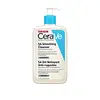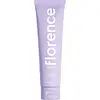What's inside
What's inside
 Key Ingredients
Key Ingredients

 Benefits
Benefits

 Concerns
Concerns

 Ingredients Side-by-side
Ingredients Side-by-side

Water
Skin ConditioningSodium Lauroyl Sarcosinate
CleansingCocamidopropyl Hydroxysultaine
CleansingGlycerin
HumectantNiacinamide
SmoothingGluconolactone
Skin ConditioningSodium Methyl Cocoyl Taurate
CleansingPEG-150 Pentaerythrityl Tetrastearate
EmulsifyingCeramide NP
Skin ConditioningCeramide AP
Skin ConditioningCeramide EOP
Skin ConditioningCarbomer
Emulsion StabilisingCalcium Gluconate
HumectantSalicylic Acid
MaskingSodium Benzoate
MaskingSodium Lauroyl Lactylate
EmulsifyingCholesterol
EmollientPhenoxyethanol
PreservativeDisodium EDTA
Tetrasodium EDTA
Hydrolyzed Hyaluronic Acid
HumectantPhytosphingosine
Skin ConditioningXanthan Gum
EmulsifyingEthylhexylglycerin
Skin ConditioningWater, Sodium Lauroyl Sarcosinate, Cocamidopropyl Hydroxysultaine, Glycerin, Niacinamide, Gluconolactone, Sodium Methyl Cocoyl Taurate, PEG-150 Pentaerythrityl Tetrastearate, Ceramide NP, Ceramide AP, Ceramide EOP, Carbomer, Calcium Gluconate, Salicylic Acid, Sodium Benzoate, Sodium Lauroyl Lactylate, Cholesterol, Phenoxyethanol, Disodium EDTA, Tetrasodium EDTA, Hydrolyzed Hyaluronic Acid, Phytosphingosine, Xanthan Gum, Ethylhexylglycerin
Water
Skin ConditioningSodium Acrylate/Sodium Acryloyldimethyl Taurate Copolymer
Emulsion StabilisingGlycol Stearate
EmollientCetyl Alcohol
EmollientGlycerin
HumectantMalic Acid
BufferingMandelic Acid
AntimicrobialGallic Acid
AntioxidantPanthenol
Skin ConditioningCyanocobalamin
Skin ConditioningAloe Barbadensis Leaf Juice
Skin ConditioningEthylhexylglycerin
Skin ConditioningSalix Alba Bark Extract
AstringentLactic Acid
BufferingGlycolic Acid
BufferingElettaria Cardamomum Seed Extract
PerfumingSantalum Album Wood Extract
PerfumingRose Extract
Skin ConditioningPyrus Malus Fruit Extract
Skin ConditioningChamomilla Recutita Extract
Skin ConditioningSaponaria Officinalis Leaf/Root Extract
Skin ConditioningSalvia Officinalis Leaf Extract
CleansingNasturtium Officinale Extract
PerfumingHedera Helix Leaf Extract
Skin ConditioningFucus Vesiculosus Extract
EmollientCitrus Limon Peel Extract
EmollientArctium Majus Root Extract
Skin ConditioningRubus Idaeus Fruit Extract
AstringentTocopherol
AntioxidantLavandula Angustifolia Flower/Leaf/Stem Extract
MaskingJasminum Officinale Flower/Leaf Extract
MaskingCucumis Sativus Fruit Extract
EmollientCucumis Melo Fruit Extract
Skin ConditioningCitrus Aurantium Dulcis Peel Extract
Emulsion StabilisingCananga Odorata Flower Extract
PerfumingAnthemis Nobilis Flower Extract
MaskingCaprylic/Capric Triglyceride
MaskingDisodium Laureth Sulfosuccinate
CleansingGlyceryl Stearate
EmollientSodium Methyl Cocoyl Taurate
CleansingSodium Cocoyl Isethionate
CleansingCocamidopropyl Betaine
CleansingPhenoxyethanol
PreservativeSodium Benzoate
MaskingPotassium Sorbate
PreservativeCitric Acid
BufferingHydroxycitronellal
PerfumingWater, Sodium Acrylate/Sodium Acryloyldimethyl Taurate Copolymer, Glycol Stearate, Cetyl Alcohol, Glycerin, Malic Acid, Mandelic Acid, Gallic Acid, Panthenol, Cyanocobalamin, Aloe Barbadensis Leaf Juice, Ethylhexylglycerin, Salix Alba Bark Extract, Lactic Acid, Glycolic Acid, Elettaria Cardamomum Seed Extract, Santalum Album Wood Extract, Rose Extract, Pyrus Malus Fruit Extract, Chamomilla Recutita Extract, Saponaria Officinalis Leaf/Root Extract, Salvia Officinalis Leaf Extract, Nasturtium Officinale Extract, Hedera Helix Leaf Extract, Fucus Vesiculosus Extract, Citrus Limon Peel Extract, Arctium Majus Root Extract, Rubus Idaeus Fruit Extract, Tocopherol, Lavandula Angustifolia Flower/Leaf/Stem Extract, Jasminum Officinale Flower/Leaf Extract, Cucumis Sativus Fruit Extract, Cucumis Melo Fruit Extract, Citrus Aurantium Dulcis Peel Extract, Cananga Odorata Flower Extract, Anthemis Nobilis Flower Extract, Caprylic/Capric Triglyceride, Disodium Laureth Sulfosuccinate, Glyceryl Stearate, Sodium Methyl Cocoyl Taurate, Sodium Cocoyl Isethionate, Cocamidopropyl Betaine, Phenoxyethanol, Sodium Benzoate, Potassium Sorbate, Citric Acid, Hydroxycitronellal
 Reviews
Reviews

Ingredients Explained
These ingredients are found in both products.
Ingredients higher up in an ingredient list are typically present in a larger amount.
Ethylhexylglycerin (we can't pronounce this either) is commonly used as a preservative and skin softener. It is derived from glyceryl.
You might see Ethylhexylglycerin often paired with other preservatives such as phenoxyethanol. Ethylhexylglycerin has been found to increase the effectiveness of these other preservatives.
Glycerin is already naturally found in your skin. It helps moisturize and protect your skin.
A study from 2016 found glycerin to be more effective as a humectant than AHAs and hyaluronic acid.
As a humectant, it helps the skin stay hydrated by pulling moisture to your skin. The low molecular weight of glycerin allows it to pull moisture into the deeper layers of your skin.
Hydrated skin improves your skin barrier; Your skin barrier helps protect against irritants and bacteria.
Glycerin has also been found to have antimicrobial and antiviral properties. Due to these properties, glycerin is often used in wound and burn treatments.
In cosmetics, glycerin is usually derived from plants such as soybean or palm. However, it can also be sourced from animals, such as tallow or animal fat.
This ingredient is organic, colorless, odorless, and non-toxic.
Glycerin is the name for this ingredient in American English. British English uses Glycerol/Glycerine.
Learn more about GlycerinPhenoxyethanol is a preservative that has germicide, antimicrobial, and aromatic properties. Studies show that phenoxyethanol can prevent microbial growth. By itself, it has a scent that is similar to that of a rose.
It's often used in formulations along with Caprylyl Glycol to preserve the shelf life of products.
Sodium Benzoate is a preservative. It's used in both cosmetic and food products to inhibit the growth of mold and bacteria. It is typically produced synthetically.
Both the US FDA and EU Health Committee have approved the use of sodium benzoate. In the US, levels of 0.1% (of the total product) are allowed.
Sodium benzoate works as a preservative by inhibiting the growth of bacteria inside of cells. It prevents the cell from fermenting a type of sugar using an enzyme called phosphofructokinase.
It is the salt of benzoic acid. Foods containing sodium benzoate include soda, salad dressings, condiments, fruit juices, wines, and snack foods.
Studies for using ascorbic acid and sodium benzoate in cosmetics are lacking, especially in skincare routines with multiple steps.
We always recommend speaking with a professional, such as a dermatologist, if you have any concerns.
Learn more about Sodium BenzoateThis gentle cleansing and foaming ingredient is known for leaving a smooth feeling in skin and hair. It is made using coconut oil.
According to the manufacturer, it is soluble in water and has resistance to hard water, acid, and alkali.
Due to its coconut base, it may not be Malassezia folliculitis safe.
Learn more about Sodium Methyl Cocoyl TaurateWater. It's the most common cosmetic ingredient of all. You'll usually see it at the top of ingredient lists, meaning that it makes up the largest part of the product.
So why is it so popular? Water most often acts as a solvent - this means that it helps dissolve other ingredients into the formulation.
You'll also recognize water as that liquid we all need to stay alive. If you see this, drink a glass of water. Stay hydrated!
Learn more about Water